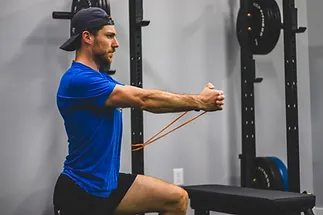Strength Training For Endurance Athletes
Strength and conditioning is critical for success in any sport. Training needs to be developed to meet the unique demands of your specific sport and strength training can maintain and improve muscle strength, muscular endurance, and balance, prevent injury, improve recovery time, optimize biomechanics, and maximize power. Many endurance athletes are unaware of the benefits of strength training in conjunction with endurance training, and the role that a structured program can play in your overall performance.
For runners, cyclists, and triathletes, incorporating strength training into your regimen can
improve your oxygen economy, which will in turn improve your times and reduce fatigue during training and races. Increasing maximal power through strength training will help you gain that edge in the sprints at the end of the race, so you can finish strong.
Muscular imbalances and weakness in certain muscles are often the cause of common (but preventable!) swimming, running, and biking injuries. Strength training can prevent such injuries by targeting systems that aerobic training alone is unable to tap into, such as the overload principle to enhance performance.
Targeting musculature that is generally undertrained and commonly causes injuries will keep you training pain free, while significantly improving your running economy through proper mechanics and muscle recruitment in all three disciplines. Since the ability to utilize the core musculature in isolation for stability and with extremity movement (in the open and closed chain) is important for performance, make sure that you’re including training that targets core control.
If you’re a beginner or are new to endurance training, you should be incorporating strength training into your training 2 to 3 times a week. And your strength exercises should target musculature to improve biomechanics, prevent injury, and improve muscular endurance. The overall load should be anywhere from 8 to 12 exercises with 2 to 3 sets each. Initially, target the muscular endurance aspect of training, and eventually you can progress to the strength aspect as you grow as an athlete.
For moderate to advanced athletes, you’ll need to incorporate the recommendations for beginners, but with an extra emphasis on compound movements, single leg strength, power movements, and more challenging core and pelvic exercises. With the large amounts of endurance training that competitive athletes often do, however, comes the need to be cautious not to overtrain by doing too much strength training.
Choose exercises that incorporate multiple aspects of fitness, which offer the added benefit of addressing multiple aspects without overtaxing your body. For example, perform a reverse lunge with overhead press and march.
Tri-strong Program
Periodization is also important to plan ahead in a backwards fashion from the date of your race. Initially, you will need to build a strength base and increase muscular endurance in a higher repetition range for 6-10 weeks. Secondly, follow the base strength block with a moderate repetition range and weight for 4-6 weeks. The third phase will be a power block which will focus on heavier weight and quick explosive movements. Finally, depending on how you respond as an individual you will need to back your overall load and weight by half 2-3 weeks out from your race for the taper phase.
During the off season or when there are no formal races scheduled in your near future is a valuable time to incorporate strength training into your training. This is the time to identify and strengthen your weaknesses and become a more well rounded athlete. With the lack of availability to gyms and equipment, your strength training does not need to be done in a gym and can be structured to generally become a well rounded athlete, because triathletes need to be ready for any situation or conditions that may be thrown your way.
General exercise principles and selection:
Lunges
Squats
Deadlifts
Balance/ stability
Bent knee and straight leg calf raises
Abductor/ adductor isometric strength
Hip flexor strength
Step ups
Plyometrics
Push, press, w/ serratus anterior exercises
Rotator cuff strength
Ankle stability/ strength
Pull-ups
Rows
Hip rotator and gluteal strength
Single leg exercises
Core strength: Leg raises, planks, pallof presses, deadbug, sit ups, rotational, chops, core stability w/ extremity movement
Dr. Brandon Ostrander, PT, DPT, CSCS, USAT
Change The Game Endurance
brandon.ostrander@changethegamept.com
(910) 915-4888
814 N 4th st.
Wilmington, NC 28401


